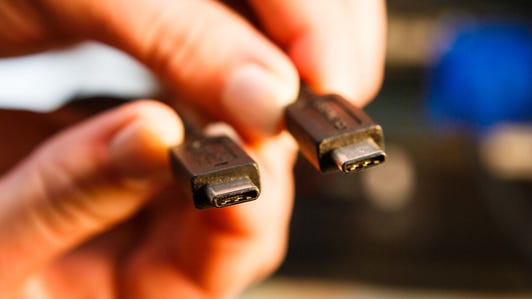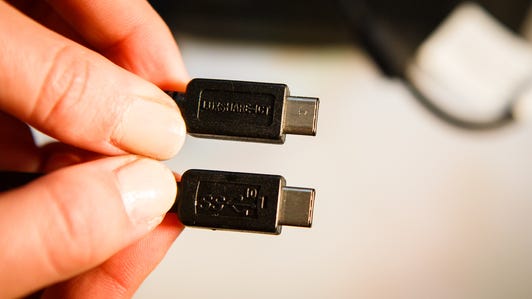One venerable computing technology, USB, could be about to help kill off an even older standard, the 3.5mm audio jack.
The 3.5mm audio jack was popularized as the way to plug headphones into Sony’s portable Walkman tape player and got a new lease on life as a way to handle audio on virtually every mobile phone and PC. But if Intel and its allies get their way, the new USB Type-C connector that’s spread to some high-end PCs and phones will replace it in coming years.
One big problem with removing the 3.5mm jack is that countless sets of earbuds and headphones suddenly become useless unless you buy an easily misplaced adapter. Another is that it’s harder to charge a phone if you have headphones plugged into its sole port.
But at the Intel Developer Forum in San Francisco on Tuesday, Intel architects Brad Saunders and Rahman Ismail sketched out a coming USB audio standard that could help push the 3.5mm jack aside. The new specification, due this quarter, adds features to ensure a USB headphone doesn’t drain too much battery power and defines how buttons for pausing music or lowering volume work.
The work “will really make USB Type-C the right connector for audio,” Saunders said.
Technology standards arrive all the time, but the 3.5mm audio jack is a surprisingly contentious issue. Rumors that the upcoming iPhone 7 won’t have one have worked the tech industry into a lather — with some people hoping the jack will stay and others more sanguine about its possible departure.
Why you might be happy to lose the 3.5mm jack
But there are good arguments to be made for embracing USB audio, Saunders said, and the companies that make USB controller chips are very excited about the idea.

 Enlarge Image
Enlarge ImageIntel has high hopes for USB’s future.
Stephen Shankland/CNET
For one thing, the 3.5mm audio jack takes up precious volume inside phones, which we all want to be as slim as possible. For another, the analog circuitry of 3.5mm audio can cause interference that disrupts other electronics in a phone, Saunders said.
And digital audio opens up possibilities for lots of sound-processing options without requiring expensive headphones or earbuds. That includes audio effects to make music sound like it’s playing in a big concert hall, or signal processing to cancel noise like jet engines or rumbling trains. “All of those come into play if audio is in a digital domain,” Saunders said, which would let phone makers offer premium features without having to sign deals with premium audio companies like Dolby or Bose.
USB devices have controller chips that consume power. That’s no problem for PCs with big batteries, but it is for phones. That’s why the new USB audio standard requires power management abilities like turning off features that aren’t being used, Saunders said. As a result, with USB headphones, “the difference in battery life is negligible” compared with 3.5mm audio jacks.
There’s another ability for USB on the way too: video. DisplayPort and HDMI are good for high-end video, but many people have more modest needs. An updated USB video technology under development will handle those needs — and unlike HDMI and DisplayPort, will work even if people are using a USB hub to plug lots of devices into a single USB port on their laptop or phone.
“It’s not a replacement for HDMI,” Ismail said. “It’s good enough to do productivity work or watch movies, but not for a gaming system.”
Where you’ll find USB Type-C already
The USB Type-C connectors are new to many people but have started arriving on devices like the Apple MacBook and HP Spectre laptops as well as the Google Nexus 6P and Samsung Galaxy Note 7 phones. The port is destined for greatness.
The first advantage you’ll find with USB Type-C is that the cables are reversible — there’s no fiddling with the cable to figure out which way is up. The next advantage is that Type-C can carry more power to charge your phone faster and even your laptop. With a new technology called USB Power Delivery, USB Type-C devices can handle nearly 100 watts of power, plenty to power all kinds of computers and devices that plug into them. USB Type-C also can carry DisplayPort video to external monitors.
There’s going to be a period of confusion, though, as we get used to the new standards. That’s especially true since you won’t be able to count on every USB port supporting every new USB feature.
But the USB Implementers Forum that develops USB is happy with the port’s progress, said President Jeff Ravencraft at the conference.
“We have a single cable that can do pretty much everything you want it to,” he said.

















